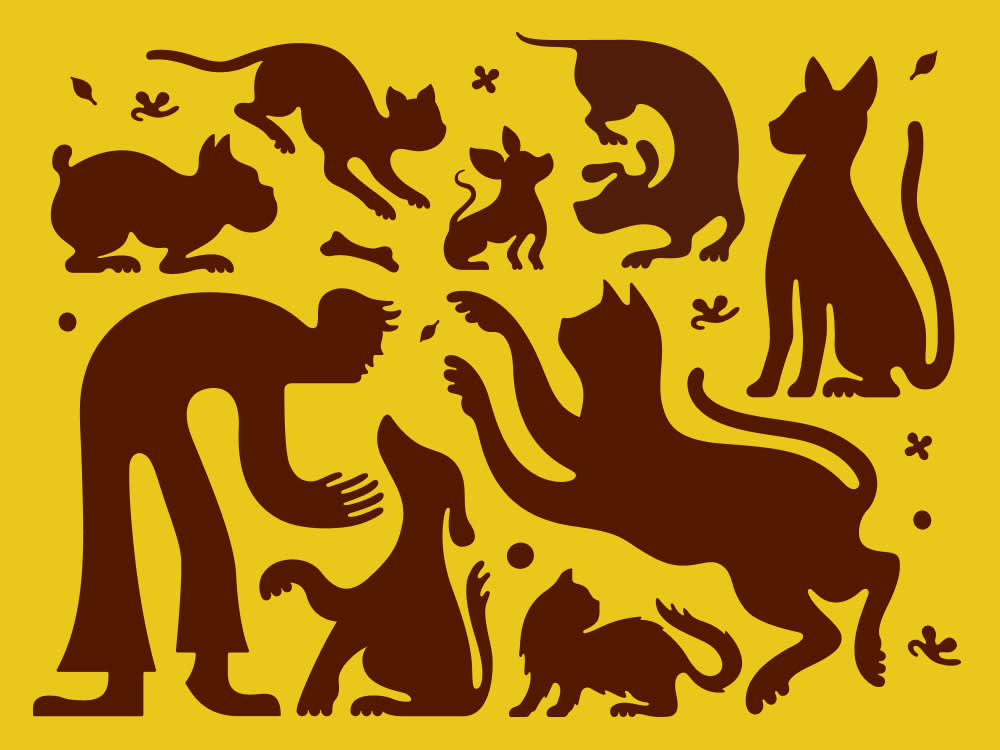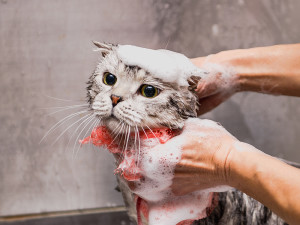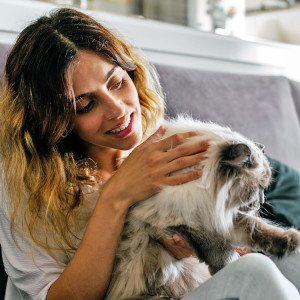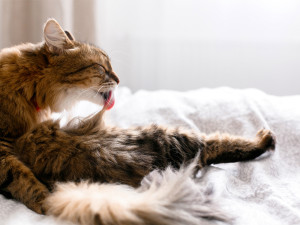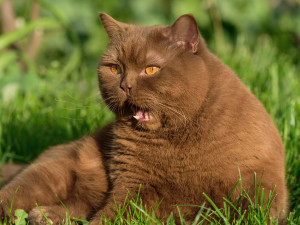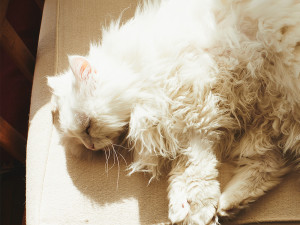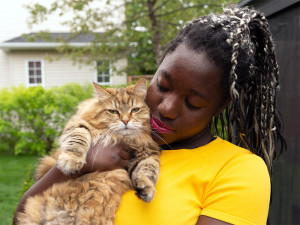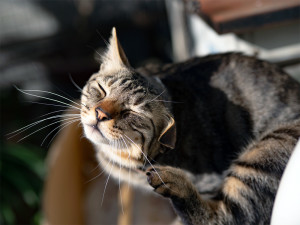Why Does My Cat Shed So Much?
In This Article:
Why Do Cats Shed Hair? What Is a Normal Amount of Shedding for Cats? Why Might Your Cat Be Shedding Excessively? How to Reduce or Deal With Shedding FAQs (People also ask)
Cats shed to remove dead hair and maintain a healthy coat. Seasonal changes, poor diet, stress, and health issues like allergies or parasites can increase shedding. Regular grooming and a balanced diet help manage shedding. Consult a vet if shedding is excessive.
Why do cats shed hair?
Nothing tells the world “I have cats!” like a coating of cat hair on your clothes. Many cat parents would love to lose the lint roller, but dealing with cat hair shedding is a normal and expected part of having a feline companion. But why do cats shed so much?
Cats shed because they’re continually losing, growing, and replacing hair. There are some factors that can affect the rate of this hair turnover, but shedding is a sign of healthy hair growth in cats. Hair growth happens in cycles:
How much do you spend on your pet per year?
In the anagen phase, hair follicles grow new hair.
This growth ends in the catagen phase, which remodels the base of the hair to be retained in the next phase.
Hair spends most of its time in the telogen phase. Hair in this phase is dead but stays locked in place in the hair follicle due to the changes in the previous phase. Telogen hair makes up the majority of a cat’s coat.
Older hair in the telogen phase is eventually shed in the exogen phase.
In the kenogen phase, shed hair leaves an empty hair follicle ready to restart the hair growth cycle.
Cats have hair in various phases all over their bodies. This variation in hair growth cycles should mean that a healthy hair coat should never have thin or bald patches due to shedding from one area all at the same time.
What is a normal amount of shedding for cats?
A normal amount of cat shedding is the amount of hair loss and regrowth needed to maintain a healthy, full coat without visible thin or bald areas. The amount of shedding varies greatly from cat to cat and breed to breed. Hairless cat breeds (obviously) don’t do much shedding. Shedding may be more obvious in longer-haired breeds because of their hair length, but short-haired cats can shed just as much. As long as routine grooming does not leave a cat with an uneven coat, the amount of shedding is generally considered normal. There are some conditions that can alter the speed of the hair growth cycle, which could result in an increase in shedding.
Why might your cat be shedding excessively?
Over time, cat parents develop a sense of how much shedding is normal. This can be tracked through how frequently you’re vacuuming carpets, sweeping floors, brushing your cat, and wiping down your clothes. An uptick in hair in the environment could indicate your cat is shedding more than normal. Some causes for this are expected, while others could indicate a problem.
Seasonal changes
Cat hair follicles are most active in the late summer and least active in the late winter. This helps to prepare them for seasonal changes. Cats grow a thicker (and slightly longer) coat in the cold winter months and maintain a lighter coat for the warmer summer months, then lose their undercoat and many of those longer hairs as weather warms in the spring.
Spring tends to be the time where shedding is most noticeable, because cats shed their undercoat and longer winter hairs during this time. There is usually a second wave of increased hair loss in the fall as cats prepare for the winter by shedding their shorter summer hairs and growing out their winter coat. So, if it seems like your cat is shedding excessively, think about the time of year first. A cat’s hair growth cycle never completely stops — even during the coldest part of the winter — meaning that there will always be some shedding happening.
Diet
A complete, well-balanced diet is vital to maintaining a healthy hair coat. Cats that are fed poor-quality food, not eating well, or have trouble absorbing nutrients due to intestinal diseases can have a poor hair coat. Excessive shedding may be an early sign, though shedding may drop off with time due to poor hair regrowth.
Age
As cats get older, their haircoat may get thinner due to atrophy of hair follicles and changes to the hair growth cycle. Older cats may shed less due to these changes. Hair may also get lighter in color due to loss of color-producing cells in hair follicles.
Stress and anxiety
Cats seem to increase shedding during times of anxiety, like vet visits. Some cats with anxiety disorders can develop a problem called psychogenic alopecia, which can result in bald patches. This degree of hair loss is not primarily due to excessive shedding, but reliance on excessive grooming as a self-calming behavior.
Stressful events like major illnesses can cause a problem called telogen effluvium. This is a true increase (or syncing) of shedding and hair loss. During illness, the hair growth cycle all over the body will get stuck in the telogen (retaining hair) phase. When the cycle restarts, all the affected hair will be lost at once as the follicles move into the anagen (regrowth) phase.
Allergies
Allergies to food, pollen, dust, or anything else in the environment can show up as skin disease. Cats with skin allergies may have increased shedding due to the effects of inflammation on hair follicles.
Parasites
Similar to allergies, inflammation from skin parasites like fleas, mites, or lice can result in increased shedding due to inflammation.
Disease or medication
Certain diseases like hyperthyroidism, hypothyroidism, diabetes mellitus, or Cushing’s disease can change hair growth cycles and affect shedding. Steroid medications can cause an initial increase in hair shedding, then hair loss as the hair fails to regrow properly.
How to help reduce or deal with shedding
Because shedding hair is a normal part of your cat’s existence, trying to reduce the amount of hair they’re losing is fruitless. Limiting shedding onto your clothes, furniture, and floors is possible though.
Groom your cat regularly
Routine cat grooming can help to catch hair before it’s shed into the environment. If your cat will tolerate it, brushing their hair regularly can spread oils to maintain a healthy coat, provide social interaction, and remove dead hair when it’s ready to fall out. If your cat doesn’t tolerate a cat brush, you can try some alternative cat grooming tools like a grooming mitt or even a slightly damp chamois cloth to help prevent shedding.
If you’ve asked yourself, “Why does my cat shed so much and have dandruff that gets all over everything?”, you may consider talking to your veterinarian about using a cat shampoo that can help with seborrhea. Bathing with an appropriate shampoo can help to reduce shedding. Many cats don’t appreciate outside efforts to keep them clean, so consider a professional groomer if you feel like attempting a bath will negatively affect your relationship.
See a veterinarian
If you feel that there’s a sudden uptick in your cat’s shedding, a change in grooming behavior, or an unhealthy appearance to their hair coat, see your veterinarian to make sure that there’s not a medical cause for the change. Your veterinarian can check your kitty out for evidence of parasites or skin allergies, screen for metabolic diseases, and make recommendations for getting your cat’s coat healthy again.
Feed an appropriate diet
As part of a strategy to maintain a lush coat, your veterinarian may recommend a diet change. Most cats do great on a balanced commercial diet labeled for cats in their life stage, but some need a little extra help. Your veterinarian can help you evaluate your cat’s current diet to see if anything needs to be changed or may recommend a hydrolyzed or novel-protein diet if skin allergies are suspected.
Medicine or supplements
There are no medications proven to help reduce shedding in cats. Supplements containing omega-3 fatty acids or vitamin A, D, or E could be recommended by your veterinarian if needed.
Overall, it’s best not to worry why your cat sheds so much hair. Be happy that your cat has a healthy coat and just learn how to coordinate your wardrobe with your cat’s coat color.
FAQs (People also ask)
What kinds of cats shed the least?
The only type of cats that don’t shed are hairless breeds, but they often have issues with overall skin health. Both short-haired and long-haired cat breeds shed regularly.
What is a normal amount of cat hair shedding?
The amount of hair a cat sheds throughout the year will vary depending on environmental conditions. A normal amount of cat hair shedding is any amount that allows a cat to have a full, healthy coat without thin or bald patches.
What season do cats shed the most?
Cats tend to shed the most in the spring and the fall as they prepare for upcoming weather changes. Cats kept in a temperature-controlled environment may shed less than ones who experience weather extremes.
